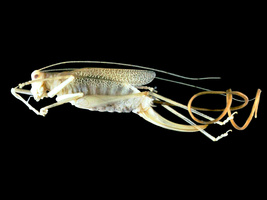 | Back to e-WV
| Back to e-WV
 The West Virginia Encyclopedia
The West Virginia Encyclopedia
 | Back to e-WV
| Back to e-WV
 The West Virginia Encyclopedia
The West Virginia Encyclopedia

Invertebrates, as animals without backbones are called, include the major part of the animal kingdom, an estimated two million kinds of multi cellular organisms. Invertebrates include a spectrum of forms varying from simple sponges to the fascinating, complicated, and versatile insects and spiders. By a very large margin they account for most species of animals in West Virginia and most individual animals as well.
Many invertebrates are found in saltwater environments. Others inhabit freshwater, including the freshwater sponges of West Virginia. A freshwater jellyfish can be found in the Ohio River and in ponds, reservoirs, and other still waters. The umbrella shaped sexual forms, nearly an inch long, are seen sporadically in great numbers on sunny late summer days. Tiny fat, hydra-like polyps, the asexual forms, are found on submerged objects year-round.
Among the flatworms, our common aquatic planarian is flattened and spindle shaped, 5–20 mm long, a carnivore and scavenger. A bit of raw liver on a string may attract planaria in a spring or stream.
Roundworms are parasites or predators of other organisms. A few grams of rich soil or pond mud may contain tens of thousands of individuals and dozens of species of these microscopic, spindle shaped animals. Nematode diseases were once common in humans but are rare now in West Virginia. Heart worm in dogs, a debilitating and deadly disease of the heart and lungs, is caused by a kind of nematode.
A nematode relative, the horsehair worm (10–70 cm) develops within a grasshopper or spider, gradually devouring the internal organs while the host still lives. Popular (and untrue) regional folklore holds that an actual horsehair placed in water will transform into a horsehair worm. In fact, the parasite remains with the host until they encounter water, which the worm enters to find a mate, leaving the depleted host to die.
Segmented worms, which are known as annelids, include the earthworms that are vital to soil formation, organic matter transformation, nutrient cycling, and as fish bait. Earthworms travel in mucus they secrete which protects their flexible skin and lubricates their passage through soil. Most common species have been introduced from the old world. While native annelids survive, especially in freshwater, they are mostly uncommon or overlooked and their identification is difficult.
Leeches are reputed as thirsty bloodsuckers, but relatively few of the 40 to 50 species in North America will feed upon mammals and birds. All are aquatic parasites or predators of reptiles, amphibians, and fishes. A few kinds will not refuse human blood if offered during a swim in a farm pond.
Two classes of mollusks occur in West Virginia, snails and clams. Snails glide by muscular action of their foot over self secreted mucus paths. Freshwater and most terrestrial snails carry a spiraled calcareous shell, as their dwelling and refuge. The head at the front of the foot has retractable, eye-bearing tentacles above the mouth. Aquatic snails feed largely on surface films of algae, diatoms, and debris. Some are predators of other mollusks and corals. Land snails and their shell-free cousins, the slugs, subsist on the tender parts of plants. The flat spired three-toothed snail, classified as a threatened species, inhabits Coopers Rock State Forest, where its sole small territory is crossed by a footpath.
Mussels, which are freshwater clams, have paired calcareous shells hinged together by an elastic ligament. The body is a headless, eyeless, hatchet-shaped foot which plows through sediments or anchors the animal in place. The foot is enclosed by a double curtain of gills and an all enveloping mantle, a cloak-like organ that secretes and maintains the shell. Food is gathered by moving currents of water over the gills through ciliary motion, trapping and holding plankton and organic debris in mucus.
Mussels, long prized for their mother of pearl shells, have been dredged nearly to extinction from the Ohio River and its tributaries. One of West Virginia’s freshwater mussels is classified as an endangered species and five as threatened species. Rules prohibit their capture and restrict the taking of other mussel species, but pollution, disturbance from river traffic, and competition from the introduced zebra mussel exert heavy pressure on the whole group.
Arthropods, a second and enormous group of segmented invertebrates, are distinguished by an external skeleton joined by flexible membranes armoring the body and its appendages. Branches of the arthropod family include insects, arachnids, and crabs. Other arthropods, the millipedes, centipedes, most crustaceans, and some primitive and immature insects retain the repeated segmental form and laddered nervous system of annelids. Arthropods are characterized by diversity and abundance. West Virginia is home to thousands of arthropod species: scores of families of insects, nine families of centipedes, 20 families of millipedes, 38 families of spiders, many crustaceans, and many rare arthropods in those and other groups.
Written by James Arnold
Buchsbaum, Ralph & L. Milne. The Lower Animals: Living Invertebrates of the World. Garden City: Doubleday, 1960.
Dindall, D. L. Soil Biology Guide. New York: John Wiley & Son, 1990.
Levi, H. & L. Levi. Spiders and their Kin. New York: Golden Press, 1968.
Pennak, R. W. Fresh-Water Invertebrates of the U.S. New York: Ronald Press, 1989.
Jezerinac, R. F. et al. "The Crayfishes of West Virginia," Bulletin 10. Ohio Biological Survey, 1995.